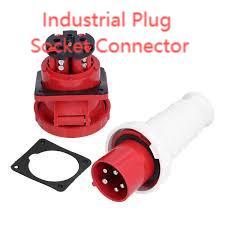Across modern production floors, the Industrial Plug Socket Connector serves as a critical interface between power sources and machinery, ensuring secure and efficient energy transfer.
Evaluating Power Load Requirements
A thorough understanding of your equipment’s electrical demands is the foundation of a reliable power distribution system. Begin by cataloging each device’s voltage, current ratings, and peak inrush currents—especially important for motors, compressors, and welding units. Apply a safety margin of at least 25% above calculated loads to accommodate surges and future expansions. Group outlets by function or production cell to simplify circuit design and streamline troubleshooting. Proper load evaluation prevents overheating, nuisance tripping, and unbalanced phases, maintaining continuous operations and safeguarding equipment longevity.
Construction and Durability Standards
Industrial connectors must withstand harsh conditions—dust, moisture, vibration, and impact. Look for housings manufactured from glass-fiber–reinforced nylon or powder-coated die-cast aluminum for superior mechanical strength and corrosion resistance. Seek IP66 or higher ratings to protect against powerful water jets and solid particles, and IK08 or IK10 ratings for impact resilience. Internally, contacts plated with silver or nickel maintain low-resistance connections through thousands of mating cycles. High-grade silicone or EPDM gaskets preserve sealing integrity across wide temperature ranges, preventing ingress that could compromise safety and performance.
Schneider Electric’s Durable Designs
Schneider Electric’s lineup of industrial connectors exemplifies robust engineering. Their products feature quick-make, quick-break contacts that reduce arcing and extend contact life. Modular backplates enable integration of circuit breakers, residual current devices, and surge protection modules without altering the main enclosure. Ergonomic lockable covers and transparent inspection windows facilitate rapid status checks and secure maintenance. Schneider’s connectors carry global certifications—UL, CE, and IECEx—ensuring compliance in diverse regulatory environments and hazardous areas, while comprehensive documentation and technical support simplify project execution.
Installation Strategies for Maximum Safety
Proper mounting and wiring practices are essential to maximize connector lifespan and maintain operator safety. Mount connectors on flat, vibration-damped surfaces using stainless-steel hardware torqued to manufacturer specifications to prevent loosening under stress. Position outlets at ergonomic heights—ideally 1.0 to 1.3 meters above floor level—to reduce strain during plug operations. Route power cables through protective conduits or trays to shield against abrasion and tripping hazards. Seal unused entries with factory-approved plugs to uphold IP ratings. After wiring, perform insulation resistance and phase-sequence tests, then document results for future audits and maintenance planning.
Maintenance and Lifecycle Management
A proactive maintenance program ensures long-term reliability and cost-effectiveness. Schedule quarterly inspections to check gaskets, seals, and covers for wear or deformation, replacing components as needed. Use contact resistance testers to detect early signs of connector degradation—pitting or discoloration indicates arcing. Clean external surfaces with pH-neutral cleaners to preserve sealing materials, and tighten terminal screws to specified torque values. When production requirements change, take advantage of modular connector systems to add features—such as smart monitoring units or surge arresters—without replacing entire assemblies. Effective lifecycle management reduces downtime and optimizes total cost of ownership.
Thoughtful selection, expert installation, and disciplined maintenance of power connectors empower manufacturers to achieve consistent performance and adaptability. For detailed specifications and guidance, visit www.nante.com



